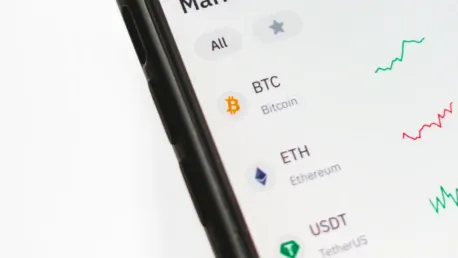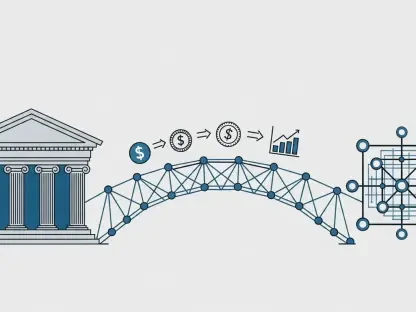The subject of analysis in this article is the potential of various cryptocurrencies trading under $1 that show promise for significant growth by 2025. The article highlights a variety of digital assets that remain affordable yet carry substantial potential in terms of innovation and technological advancement. These cryptocurrencies often represent early-stage projects with the potential to usher in future advancements within the blockchain space. Despite their low price, they offer an entry point for investors and enthusiasts into the ever-evolving world of decentralized systems.
EarthMeta: Redefining Digital Ownership in the Metaverse
EarthMeta is a blockchain initiative aligned with the goals of the Metaverse. It stands out by integrating blockchain technology with immersive experiences and is developing the $EMT token to serve as an essential component within this dynamic Metaverse. This project aims to create a comprehensive digital ecosystem for exploration, creation, and collaboration, distinguishing itself from other projects that focus solely on gaming or virtual properties.
Central to EarthMeta’s mission is the redefinition of digital ownership within the Metaverse, advocating for decentralized control and true ownership of digital assets. The $EMT token empowers users to design, trade, and reshape their digital spaces, granting creative autonomy. Furthermore, it acts as a governance mechanism, enabling its holders to influence the platform’s development actively. This autonomy ensures that user input directly affects the evolution of the Metaverse environment they inhabit.
EarthMeta envisions integrating augmented reality (AR) and virtual reality (VR) technologies to enhance user engagement by blending virtual and real-world interactions seamlessly. By adopting these advancements, it aims to create a more immersive experience that captures the essence of both realms. The $EMT token is set for listing, making this a timely opportunity to engage with the project before its anticipated growth reshapes the Metaverse landscape significantly.
TRON: Empowering Content Creators
TRON, created in 2017 by the Tron Foundation, was initially based on the Ethereum network but later transitioned to its independent TRON network. This transition was pivotal to TRON’s mission to empower content creators by eliminating intermediaries, allowing them to retain full ownership of their digital content. By doing so, TRON supports smart contracts, decentralized applications (dApps), and various blockchain systems, positioning it as an attractive alternative to Ethereum, especially for creators seeking to avoid high transaction fees.
Justin Sun, the founder and CEO of TRON, has played a vital role in the project’s success, actively engaging with the community and pursuing strategic partnerships. His leadership has been crucial in positioning TRON to transform the digital entertainment sector by leveraging blockchain technology. Moreover, TRON’s focus on decentralization and content ownership continues to attract a growing user base and developer community, fostering further innovation within its ecosystem.
TRON’s blockchain network is designed to handle high transaction volumes with speed and efficiency, ensuring that content creators and users experience a seamless platform. This emphasis on scalability and security has cemented TRON’s place as a significant player in the blockchain industry, and its utility continues to expand as more developers and creators adopt its technology.
Stellar: Facilitating Global Financial Transactions
Stellar (XLM), launched in 2015 by the Stellar Development Foundation, is designed to facilitate global financial transactions by connecting people, banks, and financial institutions. Stellar aims to provide fast, low-cost exchanges between cryptocurrencies and traditional currencies, using its native token, XLM, to facilitate these transactions efficiently. This focus on streamlined, affordable financial exchanges is at the core of Stellar’s mission to revolutionize the global money transfer industry.
The network’s emphasis on aiding individuals in developing countries by providing access to affordable financial services makes it particularly valuable for global remittances. By enabling quick and inexpensive transactions, Stellar helps bridge the financial gap for millions of unbanked or underbanked people, enhancing financial inclusion. This mission positions Stellar as a critical player in the effort to democratize access to financial services globally.
Stellar’s multi-currency transaction capability and decentralized exchange further enhance the speed and efficiency of international payments. By providing a secure and reliable platform, Stellar facilitates seamless financial interactions across borders, helping to reduce transaction costs and improve accessibility. Its commitment to decentralization and transparency has earned it a favorable reputation among users and financial institutions alike.
Cronos: Integrating Cryptocurrency into Everyday Financial Practices
Cronos (CRO), the native cryptocurrency of the Cronos Chain developed by Crypto.com, is another noteworthy project. Primarily powering the Crypto.com Pay mobile payments app, CRO enables rapid and secure transactions while safeguarding user data. This focus on security and speed makes CRO a vital component of the Cronos ecosystem and positions it as a leading contender in the digital finance space.
The platform offers multiple utilities for CRO, including staking coins to earn fees and settling transaction fees on the network. The Crypto.com Pay app provides cashback rewards and incentives for staking CRO, promoting global cryptocurrency adoption. These incentives not only enhance user engagement but also contribute to the overall stability and growth of the Cronos network.
Cronos stands out for its expanding use cases and its role in integrating cryptocurrency into everyday financial practices. By offering a range of services that facilitate the use of digital currencies in daily transactions, Cronos is making strides in bridging the gap between traditional and decentralized finance. This strategic approach positions CRO as a promising digital asset under $1, with significant potential for growth and broader adoption.
PEPE: The Deflationary Memecoin
PEPE, a deflationary memecoin on the Ethereum blockchain, pays homage to the popular internet meme Pepe the Frog. The project leverages the success of previous meme coins and focuses heavily on community engagement to build its user base. Despite its simplicity and lack of direct utility, PEPE has gained significant traction in the market, contributing to what has been dubbed a “memecoin season” in the crypto world.
The PEPE roadmap includes listings on major exchanges and aims for a “meme takeover,” illustrating the project’s focus on fun and community aspects within the crypto space. This unique approach, centered around internet culture and shared humor, has garnered a dedicated following, highlighting the potential and resilience of memecoins in the cryptocurrency market. The success of such coins is often driven by social media trends and viral marketing, making community engagement a crucial factor in their growth.
While PEPE’s value proposition might not align with traditional investment criteria, its community-driven model has proven effective. The project’s focus on inclusivity and engagement offers a refreshing change in the often overly technical world of cryptocurrencies. As long as the community continues to support and engage with PEPE, its potential for growth remains strong.
Arbitrum: Enhancing Ethereum’s Scalability
Arbitrum (ARB) is an Ethereum layer-two (L2) scaling solution designed to enhance the Ethereum network’s speed, scalability, and cost-efficiency using optimistic rollups. Arbitrum’s native token ARB plays a crucial role in governance, allowing holders to vote on protocol upgrades and other proposals. This involvement ensures that the community has a direct say in the project’s future direction, fostering a decentralized and collaborative development process.
The project, developed by Offchain Labs, has secured substantial funding and aims to launch its layer-three solution, Orbit. Arbitrum’s airdrop of ARB tokens marked a key step toward decentralizing governance within its ecosystem, making it a significant player in the Ethereum scaling landscape. The introduction of Orbit is anticipated to further enhance the platform’s scalability and performance, providing even greater benefits to users and developers.
Arbitrum’s focus on improving Ethereum’s usability without compromising security has positioned it as a vital scaling solution. By addressing the network’s congestion and high transaction fees, Arbitrum is helping to make Ethereum more accessible and reliable for everyday use. This commitment to scalability and efficiency ensures that Arbitrum will continue to play a crucial role in the broader Ethereum ecosystem.
Algorand: Secure and Scalable Blockchain Solutions
Algorand (ALGO), established by MIT professor Silvio Micali, focuses on secure, scalable, and efficient blockchain systems suitable for real-world applications. Algorand’s protocol eliminates the need for energy-intensive mining by using a permissionless pure proof-of-stake (PoS) model, making it an environmentally-friendly blockchain. This commitment to sustainability is a significant selling point for users concerned about the environmental impact of blockchain technology.
The network aims to support computations requiring reliable performance guarantees, contributing to new forms of trust within digital transactions. Algorand’s ability to handle high transaction volumes quickly and securely makes it an attractive option for developers and businesses looking to deploy blockchain applications. This focus on performance and reliability ensures that Algorand remains competitive in a rapidly evolving industry.
Algorand’s innovative approach to blockchain technology has attracted a diverse range of projects and partnerships, further expanding its ecosystem. By providing a platform that prioritizes security, scalability, and efficiency, Algorand is well-positioned to support the next generation of blockchain applications. Its unique combination of technical expertise and practical solutions ensures that Algorand will continue to play a vital role in the future of decentralized technology.
Alexandria, which includes Algorand’s dApp (decentralized application) templates, developer resources, and a wide array of educational content, is a valuable asset for those looking to build on the network. Algorand’s holistic approach to blockchain development supports a thriving ecosystem of developers, businesses, and end-users.
The Graph: Indexing Protocol for the Decentralized Web
The Graph (GRT) is an indexing protocol enabling applications in DeFi and the broader Web3 ecosystem to query data from networks like Ethereum and IPFS. This capability is crucial for developers who need efficient access to blockchain data to build and maintain their applications. By creating and publishing open APIs, called subgraphs, developers can use GraphQL to retrieve blockchain data, simplifying the development process and enhancing user experience.
The Graph’s hosted service streamlines development by offering a reliable and scalable infrastructure for querying blockchain data. This service acts as a bridge between blockchain technology and user applications, ensuring that developers can access the data they need quickly and efficiently. The platform aims to transition to a decentralized network to enhance its capabilities further, ensuring greater security, reliability, and transparency.
The Graph also ensures economic security and data integrity through its native token, GRT. This token incentivizes data indexing and query processing, contributing to the overall health and efficiency of the network. As The Graph continues to evolve, its commitment to providing reliable, decentralized public infrastructure will play a crucial role in the growth and adoption of Web3 technologies.
The broad adoption of The Graph by prominent DeFi projects highlights its importance in the blockchain space. By reducing the complexity of data access and ensuring reliability, The Graph is helping to drive innovation and growth within the decentralized web. As demand for decentralized applications continues to rise, The Graph’s role in the ecosystem will only become more critical.
The Sandbox: Blockchain-Based Virtual World
The Sandbox (SAND) is a blockchain-based virtual world allowing users to create, build, buy, and sell digital assets within a gaming context. Launched in 2011, The Sandbox combines decentralized autonomous organizations (DAOs) and non-fungible tokens (NFTs) to promote a “play-to-earn” model. This innovative approach allows users to monetize their gaming experiences and gain tangible rewards for their creativity and engagement within the platform.
The SAND utility token facilitates transactions on the platform, supporting decentralized governance and enabling user influence on project development. By giving users a say in the direction of the platform, The Sandbox fosters a sense of community and shared ownership. This participatory approach has helped The Sandbox gain significant traction and credibility within the blockchain and gaming communities.
Major brand partnerships have also contributed to The Sandbox’s success, helping it become a leader in integrating blockchain technology into gaming. These partnerships not only add value to the platform but also attract a broader audience, enhancing its reach and potential for growth. The combination of innovative technology, community engagement, and strategic partnerships positions The Sandbox as a promising digital asset with substantial growth potential.
In addition to its focus on gaming, The Sandbox is exploring various other applications for its technology, including virtual events, digital real estate, and content creation. This versatility ensures that the platform remains relevant and adaptable as the blockchain and virtual reality industries continue to evolve.
Jupiter: Decentralized Exchange on the Solana Blockchain
The focus of this article is exploring the potential of various cryptocurrencies that are currently valued under $1 but show the promise of significant growth by 2025. It examines a range of affordable digital assets that possess considerable potential in terms of innovation and technological advancements. These cryptocurrencies typically represent early-stage projects that have the capability to drive future progress within the blockchain arena. Despite their lower price points, they provide a gateway for investors and enthusiasts to enter the dynamic and constantly evolving world of decentralized systems.
In particular, these low-cost cryptocurrencies offer a unique opportunity for novice investors to dip their toes into the crypto market without requiring a substantial financial commitment. This makes them attractive not only for individuals looking to diversify their investment portfolios but also for those interested in supporting groundbreaking technologies at their nascent stages. By investing in these affordable cryptocurrencies, users can potentially benefit from significant returns on investment (ROI) as these digital assets mature and gain wider adoption in the coming years.
The article also underscores the importance of conducting thorough research before embarking on any investment, especially in the volatile crypto market. By staying informed and carefully evaluating each project, investors can make well-informed decisions and identify the most promising opportunities amidst the vast array of cryptocurrencies available today.









